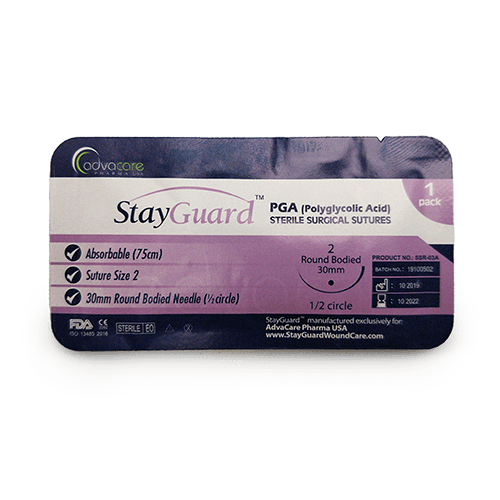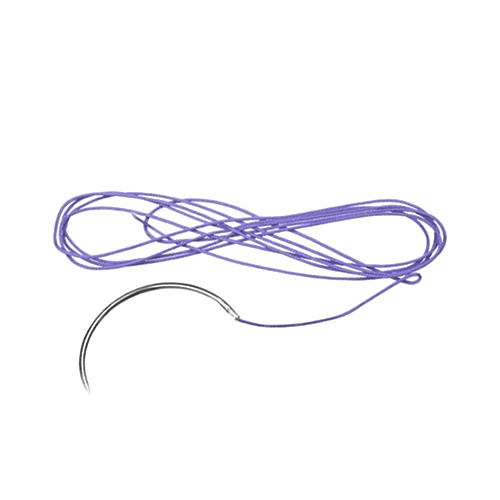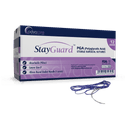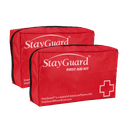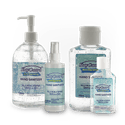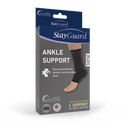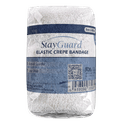- Home›
- Medical Devices›
- Skin & Wound Care›
- Wound Closure Instruments›
- Absorbable Sutures
Absorbable Sutures
Material
Type
Color
Needle
Needle Point Type
Needle Shape
Needle Length
Suture Diameter
Suture Length
Packaging
What are Absorbable Sutures?
Absorbable Sutures are surgical threads that are naturally broken down and absorbed by the body over time. Dissolvable sutures have various types and lengths. These are commonly used in surgeries to close incisions or wounds, eliminating the need for suture removal and reducing the risk of infection or irritation.
Absorbable sutures come in different types, such as synthetic and natural. Synthetic absorbable sutures are made from materials like polyglycolic acid (PGA), polydioxanone (PDO), or PGLA, which is combination of copolymer of Poly-Glycolic Acid (PGA) and Poly-Lactic Acid (PLA). These materials are broken down by the body's natural processes and are commonly used in internal surgical procedures, such as gastrointestinal or gynecological surgeries. Natural absorbable sutures, on the other hand, are typically made from materials like catgut or collagen derived from animal sources. They are commonly used in procedures where a shorter-term absorption is desired, such as in superficial skin closures or oral surgeries.
The choice of absorbable sutures, such as Polyglactin 910 (Vicryl™), depends on various factors, including the type and location of the surgical procedure, the tension on the wound, and the expected healing time. For example, PGA sutures are known for their strength and are often used in procedures where long-term wound support is needed. PLA sutures have a slower absorption rate, making them suitable for procedures with a longer healing time. PDO sutures offer good tensile strength and are commonly used in plastic surgery or cosmetic procedures.
It is important to note that the absorption rate of these sutures can vary depending on factors such as the patient's individual healing response, the suture size, and the specific type of suture used. The surgeon will consider these factors when selecting the appropriate absorbable suture for each surgical case.
When it comes to Absorbable Sutures, you can count on AdvaCare Pharma. We are committed to manufacturing products that meet the highest standards of quality and safety. Our production facilities are ISO and CE certified, and we adhere to all healthcare and regulatory guidelines. Regular inspections are conducted to ensure the consistent availability of dependable medical supplies.
Disclaimer: AdvaCare Pharma is not the owner of the brand name Vicryl™. The use of this brand name is for illustrative purposes only and does not imply endorsement or affiliation.
Product Specifications
Material
Type
Needle Type
Needle Shape
Chromic Catgut (CC)
Chromic Catgut (CC) absorbable surgical sutures made from natural animal collagen. It features a monofilament structure and is available in brown or green color. The suture comes with needle lengths ranging from 13mm to 50mm and suture lengths of 45cm, 75cm, and 150cm. It is completely absorbed by the body within 90 days and offers a tensile strength of 7-14 days. The Chromic Catgut suture is sterile, making it suitable for various surgical procedures.
The monofilament structure of catgut sutures ensures smooth passage through tissues, minimizing tissue trauma during placement and reducing the risk of suture-related complications. The availability of catgut sutures in brown or green aids in easy identification and differentiation during procedures, allowing for efficient surgical techniques and precise wound closure. Moreover, the complete absorption of catgut sutures within 90 days eliminates the need for removal, simplifying the post-operative care process and reducing patient discomfort.
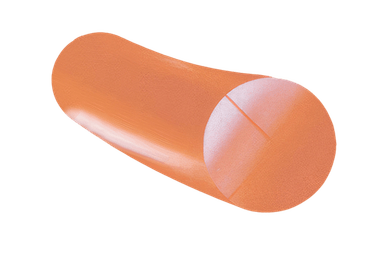
Plain Catgut (CP)
Plain Catgut (CP) absorbable surgical sutures are made from natural animal collagen. It features a monofilament structure and comes in an ivory color. The suture is available with needle lengths ranging from 13mm to 50mm and suture lengths of 70cm, 75cm, 90cm, and 150cm. It is completely absorbed by the body within 70 days and provides a tensile strength of 7-14 days. The Plain Catgut suture is sterile, making it suitable for various surgical procedures.

Polyglycolic Acid (PGA)
Polyglycolic Acid (PGA) absorbable surgical suture is made from synthetic material. It features a braided structure and is available in violet or undyed colors. With needle lengths ranging from 13mm to 50mm and suture lengths of 75cm, 90cm, and 150cm, it offers versatility in different surgical procedures. The PGA suture is completely absorbed by the body within 50-70 days and retains 75% of its tensile strength after 14 days. It is sterile, ensuring safety and reliability in medical settings.
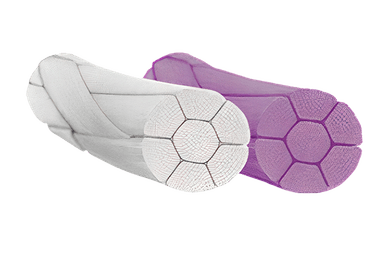
Rapid Polyglycolic Acid (Rapid PGA)
Rapid Polyglycolic Acid (Rapid PGA) suture is an absorbable surgical suture made from synthetic material. It features a braided structure and comes in an undyed color. With needle lengths ranging from 13mm to 50mm and suture lengths of 75cm, 90cm, and 150cm, it offers flexibility in various surgical procedures. The Rapid PGA suture is completely absorbed by the body within 50-70 days and retains 75% of its tensile strength after 14 days. It is sterile, ensuring safety and reliability in medical applications.
The braided structure of polyglycolic acid sutures enhances their tensile strength and knot security, providing reliable wound closure in diverse surgical procedures. The undyed color of these sutures allows for easy visualization during surgery, ensuring precise placement and minimizing the risk of suture-related complications. Additionally, the complete absorption of polyglycolic acid sutures within 50-70 days eliminates the need for suture removal, simplifying post-operative care.

Polyglactin 910 (PGLA)
Polyglactin 910 (PGLA) suture, popularly known as Vicryl™, is an absorbable surgical suture made from synthetic material. It features a braided structure and is available in violet or undyed color options. The suture is coated with calcium stearate for smoother handling. With needle lengths ranging from 13mm to 50mm and suture lengths of 75cm, 90cm, and 150cm, it offers versatility in various surgical procedures. The PGLA suture is completely absorbed by the body within 50-70 days and retains 75% of its tensile strength after 14 days. It is sterile, ensuring safety and reliability in medical applications.
The braided structure of polyglactin sutures enhances their handling characteristics, allowing for secure knot tying and reliable wound closure. The violet or undyed color options of polyglactin sutures aid in easy identification during surgical procedures, promoting efficiency and accuracy during placement.
Disclaimer: AdvaCare Pharma is not the owner of the brand name Vicryl™. The use of this brand name is for illustrative purposes only and does not imply endorsement or affiliation.
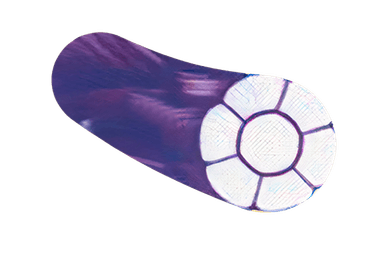
Polydioxanone (PDS/PDO)
Polydioxanone (PDS/PDO) suture is an absorbable surgical suture made from synthetic material. It features a monofilament structure and is available in violet or undyed colors. With needle lengths ranging from 13mm to 50mm and suture lengths of 75cm, 90cm, and 150cm, it offers versatility in various surgical procedures. The PDS/PDO suture is completely absorbed by the body within 180-210 days, while retaining 75% of its tensile strength after 14 days. PDS sutures are sterile, ensuring safety in medical applications.
The monofilament structure of PDO/PDS sutures allows for smooth tissue passage, reducing trauma and improving patient comfort during wound closure. The availability of PDO/PDS sutures in violet or undyed colors enhances visibility and promotes easy identification during procedures, facilitating precise placement. Additionally, the prolonged absorption period of 180-210 days allows for prolonged wound support while gradually degrading, providing ample time for tissue healing and minimizing the need for suture removal.

Poliglecaprone 25 (PGCL)
Poliglecaprone 25 (PGCL) suture is an absorbable surgical suture made from synthetic material. It features a monofilament structure and is available in violet or undyed colors. With needle lengths ranging from 13mm to 50mm and suture lengths of 75cm, 90cm, and 150cm, it offers flexibility for various surgical procedures. The PGCL suture is completely absorbed by the body within 90-120 days, while retaining 65% of its tensile strength after 14 days. It is sterile, ensuring safety and reliability in medical procedures.
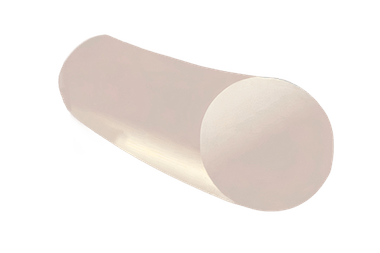
Absorbable
Absorbable sutures are made from materials that the body can break down and absorb over time. They are commonly used for internal sutures or in areas where it is difficult to remove sutures after healing, such as deep layers of tissue. The absorption time of absorbable sutures may vary depending on the specific material used.
The type of needle used in absorbable sutures play a critical role in surgical procedures. Needles can have a sharp point, as well as sharp sides that facilitate cutting, or they can be spatula-shaped to aid in tissue dissection and retention. Understanding which side of the needle is blunt is crucial to prevent unintended tissue dissection or cutting in undesirable directions.
The provided image presents drawings of various needle shapes, enabling surgeons to visualize the needle's point, tip, and the locations of sharp and blunt sides. Choosing the appropriate needle is essential to minimize tissue trauma and promote optimal healing outcomes.
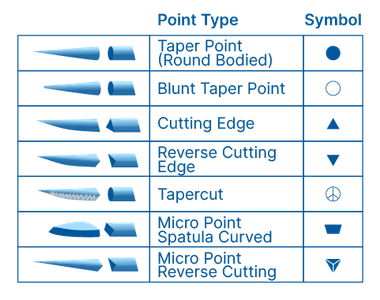
The shape of the needle in absorbable sutures varies in terms of curvature, which has important implications in surgical procedures. Needles with larger curvatures are beneficial in narrow surgical fields where delicate tissue needs to be isolated without causing damage to neighboring structures. Smaller curvatures are useful for making shallow passes, while longer needles provide enhanced control and grip of a larger amount of tissue.
Ultimately, the surgeon's preference plays a crucial role, as different surgical techniques can be effectively executed using more than one type of needle. Choosing the appropriate needle shape ensures precision and successful surgical outcomes.
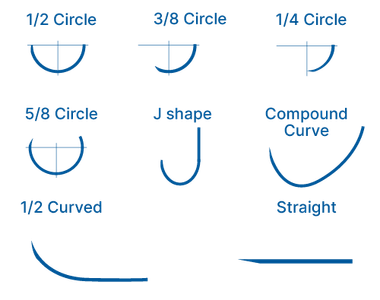
Why choose us as your Absorbable Sutures manufacturer?
AdvaCare Pharma has established itself as a dependable manufacturer of Absorbable Sutures and other high-quality medical supplies for wound closure. Our collaborations with distributors, hospitals, clinics, NGOs, and pharmacies in 65 markets worldwide underscore our commitment to excellence and customer satisfaction.
At AdvaCare Pharma, our primary objective is to manufacture surgical sutures, including catgut, PGA, rapid PGA, PGLA and other types of absorbable sutures, that are CE and ISO-certified while remaining cost-effective for healthcare institutions. Through our StayGuard™ line of skin and wound care products, we strive to contribute to the well-being of patients worldwide with our comprehensive range of absorbable sutures manufactured by AdvaCare Pharma.
Uses
How should Absorbable Sutures be used?
To use absorbable sutures:
- Start by ensuring that a sterile environment and the necessary instruments are prepared.
- Hold the needle holder firmly and grasp the suture needle near its midpoint.
- Begin by inserting the needle into the tissue, making sure to maintain a proper angle and depth according to the specific wound and tissue type.
- Pull the needle through the tissue until the suture material is evenly distributed on both sides of the wound.
- Use the needle holder to tie a knot, ensuring that it is secure but not overly tight.
- Trim the excess suture material, leaving an appropriate length for proper wound closure.
Repeat the process for additional sutures as needed, ensuring proper spacing and tension for optimal wound closure.
What happens after the surgical procedure is done?
After suturing, clean and dress the wound according to medical guidelines and provide any necessary post-operative instructions to the patient.
Regularly monitor the wound for healing progress and consult with a healthcare professional for any concerns.
When should Absorbable Sutures be used instead of non-absorbable sutures?
Absorbable sutures are typically used in situations where the sutures are intended to degrade and be absorbed by the body over time. Here are some scenarios where absorbable sutures are preferred over non-absorbable sutures:
- Internal Tissues: Absorbable sutures are commonly used for closing internal tissues or organs, such as the gastrointestinal tract, bladder, or uterus, where it is impractical or unnecessary to remove sutures postoperatively.
- Deep Tissues: In surgeries involving deep tissue layers, absorbable sutures provide temporary wound support during the initial healing phase and gradually lose tensile strength as the tissues heal and regain strength.
- Pediatric Patients: Absorbable sutures are often preferred for pediatric patients or individuals who may have difficulty tolerating suture removal procedures, minimizing discomfort and trauma associated with suture removal.
- Rapid Healing: In procedures where rapid wound healing is desired, such as in emergency surgeries or trauma cases, absorbable sutures promote faster healing by gradually breaking down and facilitating tissue repair.
- Cosmetic Surgeries: In cosmetic surgeries where sutures are used to close incisions in highly visible areas, absorbable sutures may be preferred to minimize scarring and eliminate the need for suture removal appointments.
- Reduced Infection Risk: Absorbable sutures eliminate the risk of suture-related infections associated with retained non-absorbable sutures, making them ideal for contaminated or infected wounds where minimizing foreign material in the body is crucial.
FAQs
How do Absorbable Sutures work?
Absorbable sutures are made from materials that naturally break down and are absorbed by the body over time. The body's enzymes gradually degrade the sutures, allowing the wound to heal while the sutures dissolve, eliminating the need for suture removal.
What are the different materials used for Absorbable Sutures?
Absorbable sutures are available in various materials, including Chromic Catgut (CC), Plain Catgut (CP), Polyglycolic Acid (PGA), Rapid Polyglycolic Acid (Rapid PGA), Polyglactin 910 (PGLA), Polydioxanone (PDS/PDO), and Poliglecaprone 25 (PGCL). Each material has unique characteristics that make it suitable for specific surgical procedures or wound types. For instance, Chromic Catgut is treated to prolong absorption, while Polydioxanone provides extended wound support. The choice of suture material depends on the specific needs of the patient and the surgical procedure being performed.
How do Absorbable Sutures differ from non-absorbable sutures?
Absorbable sutures are naturally broken down and absorbed by the body over time, eliminating the need for removal. Unlike non-absorbable sutures, which remain in the body indefinitely, absorbable sutures offer temporary wound support and reduce the risk of suture-related complications.
How long does it take for Absorbable Sutures to dissolve?
The rate of absorption can vary depending on factors such as the type of suture used, the size of the suture, and the patient's healing response. Generally, absorbable sutures can take anywhere from a few weeks to several months to dissolve completely.
When might Absorbable Sutures not be appropriate to use?
Absorbable sutures may not be appropriate for certain situations, such as wounds under high tension or in areas where prolonged wound support is needed. In these cases, non-absorbable sutures may be more suitable to ensure proper wound closure and healing.
How should wounds with Absorbable Sutures be cared for?
Proper wound care is important for the healing of wounds with absorbable sutures. Following the healthcare professional's instructions, keeping the wound clean and dry, and avoiding excessive tension or trauma to the area are essential. Regular follow-up visits to monitor the healing progress and ensure that the sutures are being absorbed properly are also recommended.
What quality assurance measures are in place for your Absorbable Sutures?
We adhere to strict quality assurance processes throughout the design, manufacturing and distribution of our surgical sutures, including but not limited to CE, ISO and/or USFDA certifications, to ensure they meet the highest standards of quality and safety.
Can I access product specifications and technical documents for your Absorbable Sutures?
Yes, product specifications and technical documents for our surgical sutures are available for product registration purposes and/or upon request for distributors and healthcare professionals.
Can I receive assistance with regulatory matters for importing your Absorbable Sutures?
We offer extensive regulatory support to our distributors, aiding in navigating local regulations and facilitating the importation of our surgical sutures. With the expertise of our Regulatory Affairs Department, which includes qualified professionals such as pharmacists, biomedical engineers, QA specialists, and documentation experts, we ensure a seamless product registration experience.
Is marketing assistance available for distributors of your Absorbable Sutures?
Absolutely! We offer comprehensive marketing support and resources to empower distributors in promoting our surgical sutures, enhancing brand visibility, and ensuring successful product distribution in their target markets.
References
Systematic review of absorbable vs non-absorbable sutures used for the closure of surgical incisions
This systematic review analyzed 10 randomized controlled trials involving 1354 patients to compare the efficacy of absorbable sutures (AS) versus non-absorbable sutures (NAS) for skin closure in surgical incisions. The study found that absorbable sutures are similar to non-absorbable sutures in preventing surgical site infections and other complications. Absorbable sutures were associated with a reduced risk of wound dehiscence compared to non-absorbable sutures.
Using Absorbable Sutures for Traumatic Wound Closure to Avoid Additional Hospital Visits for Suture Removal During the COVID-19 Pandemic: A Randomized Controlled Trial
This study focused on the use of absorbable sutures for traumatic wound closure during the COVID-19 pandemic to reduce hospital visits for suture removal. The research involved 471 patients with traumatic skin lacerations and found that absorbable sutures are safe for wound healing and there are no statistically significant difference in infection rates. They also reduced postoperative hospital visits compared to non-absorbable sutures since suture removal is not necessary.

You might be interested in...
Why AdvaCare Pharma?
As an industry leader, we are aware of our responsibility to provide affordable and sustainable solutions to improve healthcare worldwide.

